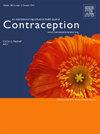北卡药房米索前列醇处方和配药的趋势
IF 2.3
2区 医学
Q1 OBSTETRICS & GYNECOLOGY
引用次数: 0
摘要
目的本研究的目的是评估米索前列醇在北卡罗莱纳州药房的配药实践。我们试图确定米索前列醇在低可及医疗保健县、农村县和按药房类型分配的趋势。方法采用秘密购物者法对药店是否配发米索前列醇进行评估。这个神秘购物者自称是诊所工作人员。采用卡方检验和Fisher精确检验进行统计分析。结果在北卡罗莱纳州100个县中,有94个县(94%)被联系。99个县(99%)有连锁药店,95个县(95%)有独立药店。173家(77.6%)药房有米索前列醇配药,12家(5.4%)药房有条件配药,38家(17.0%)药房未配药。连锁药店配发米索前列醇96(55.5%)的比例高于独立药店77 (44.5%)(p<0.0001)。连锁药店在城市地区的比例为72(53.2%),而在农村地区的比例为55 (46.8%)(p < 0.01)。农村县与城市县配药米索前列醇的比例差异无统计学意义(p=0.935)。低可及性卫生保健县与非低可及性卫生保健县的药房配药状况比例无差异(p=0.518)。不配发米索前列醇最常见的原因是库存不足(18)和有限使用的库存费用(5)。结论独立药房配药米索前列醇的比例较低。鉴于独立药店更有可能为农村社区和种族和少数民族服务,需要进一步研究和干预措施,以扩大通过独立药店获得米索前列醇的机会。本文章由计算机程序翻译,如有差异,请以英文原文为准。
TRENDS IN MISOPROSTOL PRESCRIBING AND DISPENSING ACROSS NORTH CAROLINA PHARMACIES
Objectives
The aim of this study is to assess misoprostol dispensing practices across North Carolina pharmacies. We sought to identify trends in misoprostol dispensing in low access healthcare counties, rural counties, and by pharmacy type.
Methods
We used a secret-shopper approach to assess whether pharmacies dispense misoprostol. The secret-shopper called in the role of clinic staff. Chi-squared tests and Fisher’s exact tests were used for statistical analysis.
Results
Of the 100 counties in North Carolina, 94 (94%) counties were contacted. Ninety-nine (99%) counties had a chain pharmacy represented and 95 (95%) had an independent pharmacy represented. Some 173 (77.6%) pharmacies dispensed misoprostol, 12 (5.4%) had conditional dispensing practices, and 38 (17.0%) did not dispense misoprostol. Chain pharmacies were more likely to dispense misoprostol 96 (55.5%) compared to independent pharmacies 77 (44.5%) (p<0.0001). Chain pharmacies were also more likely to be in urban areas 72 (53.2%) compared to rural areas 55 (46.8%) (p<0.01). There was no difference in the proportion of pharmacies dispensing misoprostol in rural vs urban counties (p=0.935). There was no difference in proportion of pharmacies dispensing status by low access healthcare counties vs. counties not designated as low access (p=0.518). The most common reasons for not dispensing misoprostol were unavailable in stock (18) and expense of stocking for limited use (5).
Conclusions
Independent pharmacies were less likely to dispense misoprostol. Given that independent pharmacies are more likely to serve rural communities and racial and ethnic minorities, further research and interventions are needed to expand access to misoprostol through independent pharmacies.
求助全文
通过发布文献求助,成功后即可免费获取论文全文。
去求助
来源期刊

Contraception
医学-妇产科学
CiteScore
4.70
自引率
17.20%
发文量
211
审稿时长
69 days
期刊介绍:
Contraception has an open access mirror journal Contraception: X, sharing the same aims and scope, editorial team, submission system and rigorous peer review.
The journal Contraception wishes to advance reproductive health through the rapid publication of the best and most interesting new scholarship regarding contraception and related fields such as abortion. The journal welcomes manuscripts from investigators working in the laboratory, clinical and social sciences, as well as public health and health professions education.
 求助内容:
求助内容: 应助结果提醒方式:
应助结果提醒方式:


